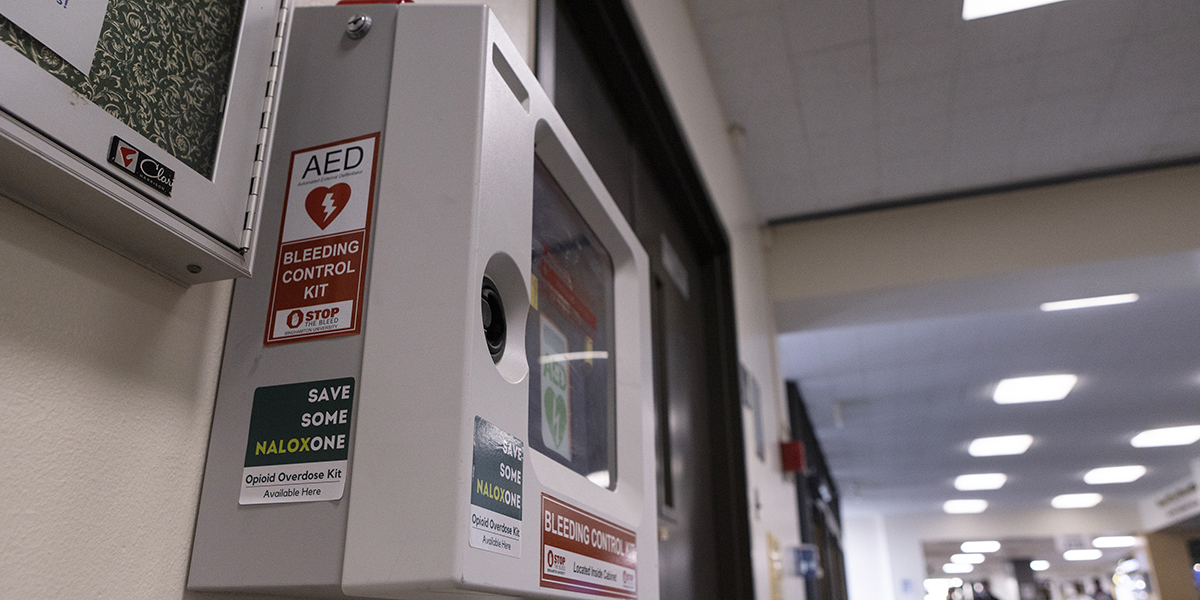NARCAN® now available on campus
The opioid overdose nasal spray is now included with automated external defibrillators (AEDs) and Stop the Bleed kits in life-safety equipment stations across campus

For nearly 20 years, Binghamton University has had AED (automated external defibrillator) life-safety equipment stations available throughout campus, and Stop the Bleed supplies were added to those stations in 2017. Now, a third life-saving method is also at the ready with the addition of naloxone kits to the stations. Commonly known as NARCAN®, the naloxone can be used to revive people suffering from an opioid overdose through use of a nasal spray.
“I’ve been looking for a way to do this for years,” said David Hubeny, executive director of emergency management for the campus. “We’ve wanted to put naloxone out there due to the proliferation of opioids in the larger community and the best practice of making it publicly available. The trick was finding funding for the naloxone.”
When New York state recently mandated that naloxone be available in all residence halls, Hubeny found a way to reach the entire campus.
There are 146 life-safety equipment stations on campus, and each one now includes an AED, Stop the Bleed kit and naloxone kit, which includes two doses of naloxone and gloves, Hubeny said. “We actually have 190 AEDs on campus,” he added, “because some are in emergency vehicles. In addition, we have 400 Stop the Bleed kits on campus, including at 15 locations on campus where large groups convene.
“We would love for these life-safety equipment stations to collect dust and never get used,” Hubeny said, “but the AEDs have saved six lives on our property and have proven their value. These safety measures are highly successful.”
For the naloxone kits, Hubeny connected with Bennett Doughty, a clinical assistant professor in the School of Pharmacy and Pharmaceutical Sciences. “Bennett was the connection point for the clinical side of this, and I’m on the operational side to make the naloxone publicly available,” Hubeny said. “The partnership made this happen and happen quickly.”
Doughty directs the Opioid Overdose Prevention Program (OOPP) on campus, which provides training of non-medical people in the use of naloxone and provided the naloxone kits for the campus life-safety equipment stations. “The OOPP is funded through New York state, and we provide trainings to members of the campus community on how to administer the naloxone — twice each month, once in person and once online. We also provide naloxone kits to participants,” Doughty said.
“We’ve had a few people in training who said ‘I had to use this before’ and it did work,” Doughty said. “It can be a very scary situation, but if you have naloxone, you have the answer right there.
“In our trainings, we focus primarily on defining that opioid use disorder is a disease state and highly stigmatized,” Doughty said. “We work to really humanize those who are impacted by opioid overdoses so that our trainees are comfortable approaching them and using naloxone; as we know, opioid use disorder unfortunately affects many different community groups.”
Since fall 2019, about 1,500 people have been trained through the campus OOPP program Doughty oversees, though there are also requests for trainings by other organizations such as Residential Life and Greek Life.
A number of people are able to run the trainings. “I’m the primary contact person and do some of the trainings myself, but our TRUST (The Rural and Underserved Service Track) scholars are the true leaders of the trainings — often training other students to help run the trainings,” Doughty said. The TRUST students also do naloxone trainings for other community agencies.
“During the trainings, we do encourage participants to get naloxone through pharmacies if they have insurance,” Doughty added. “We work to distribute kits to only those that would still have a copay at a local pharmacy as we don’t want anyone to be without naloxone if at all possible. We are very fortunate that the state helps support the costs of these kits, which can range from $65 to $75 per kit.”
“In addition to programs like ours, New York state also helps cover or reduce copays for naloxone at your local pharmacy through its Naloxone Copayment Assistance Program,” Doughty added. “Any community member can go to their pharmacy and ask for a naloxone kit without a prescription and if their copay is $40 or less, the state covers that fee. If they still have a portion of a copay, then I encourage them to find their local OOPP (such as ours) as we want everyone to have this life-saving medication.”
“I’m very excited for this expansion into the life-safety equipment stations around campus,” Doughty added. “When we first started the OOPP, we wanted to touch as many residential assistant students as possible for them to be trained and spread the word. We have grown since then and now we’re getting out to as many people as possible.”
The life-safety equipment stations are inspected once a month, at a minimum, Hubeny said. “The cabinets are alarmed, so if they’re opened, a University Police Officer is dispatched immediately, but, ideally, the person who opened the cabinet is simultaneously calling 911. When responders arrive, they take over the patient care and the cabinet can be replenished immediately,” he said.

